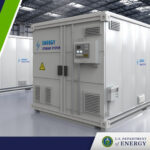Energy News Beat
The U.S. Department of Energy’s Office of Electricity (DOE-OE) has announced a significant step toward bolstering the nation’s electric grid with $15 million in funding for six innovative projects aimed at advancing energy storage resiliency. These projects, selected under the Technology Innovation for Improving Energy Storage Resiliency (TIIESR) initiative, focus on developing cutting-edge technologies to enhance the reliability, security, and affordability of energy storage systems critical to a modernized grid. This move underscores the DOE’s commitment to addressing the challenges of an aging grid infrastructure while integrating renewable energy sources and meeting growing electricity demands.
The Selected Projects
The DOE has carefully chosen six projects, each tackling unique aspects of energy storage resiliency. Below is a breakdown of the initiatives, their lead organizations, and their objectives, based on the DOE’s announcement:
-
General Electric Vernova (Boston, MA) – Awarded $2.7 million to develop a modular, scalable energy storage system with advanced cybersecurity features. This project aims to protect grid infrastructure from cyber threats, ensuring uninterrupted power delivery during disruptions.
-
University of California, San Diego (San Diego, CA) – Allocated $2.5 million to create an AI-driven energy storage management system. This technology will optimize battery performance under extreme weather conditions, improving grid reliability in climate-vulnerable regions.
-
EPRI (Palo Alto, CA) – Granted $2.5 million to advance long-duration energy storage solutions. The project focuses on cost-effective, scalable systems capable of supporting grid stability during extended outages or peak demand periods.
-
Pacific Northwest National Laboratory (Richland, WA) – Received $2.5 million to develop next-generation battery chemistries with enhanced thermal resilience. This innovation aims to reduce degradation in extreme temperatures, extending battery lifespan and reliability.
-
Siemens Corporation (Princeton, NJ) – Awarded $2.3 million to integrate energy storage with microgrid controls. This project will enable seamless transitions to backup power during outages, enhancing resiliency for critical infrastructure like hospitals and data centers.
-
Georgia Institute of Technology (Atlanta, GA) – Allocated $2.5 million to pioneer a hybrid energy storage system combining batteries with supercapacitors. This approach aims to deliver high-power bursts for rapid grid stabilization, addressing sudden demand spikes or renewable energy fluctuations.
These projects collectively aim to tackle key challenges in energy storage, including cybersecurity risks, extreme weather impacts, cost barriers, and the need for long-duration and rapid-response capabilities. By fostering innovation in these areas, the DOE is laying the groundwork for a more resilient and sustainable energy future.
Why Grid Resiliency Matters
Grid resiliency is increasingly critical as the U.S. faces a confluence of challenges: aging infrastructure, rising electricity demand, frequent extreme weather events, and the integration of intermittent renewable energy sources like solar and wind. According to the DOE, power outages cost the U.S. economy up to $70 billion annually, with weather-related disruptions accounting for a significant portion. Energy storage systems are pivotal in mitigating these risks by providing backup power, stabilizing voltage, and enabling seamless integration of renewables.
By enhancing energy storage capabilities, these initiatives will support the transition to clean energy while ensuring the grid can withstand cyber threats, natural disasters, and other disruptions.
Investment Opportunities in Grid Resiliency
For investors, the DOE’s $15 million investment signals a growing market for grid resiliency technologies, particularly in energy storage. The global energy storage market is projected to grow from $50 billion in 2024 to over $400 billion by 2030, driven by demand for resilient, sustainable energy solutions. Here’s how investors can capitalize on this trend:
-
Publicly Traded Companies:
-
General Electric Vernova (GEV): As a recipient of TIIESR funding, GE Vernova is well-positioned to lead in energy storage innovation. Its focus on cybersecurity-enhanced systems could attract partnerships with utilities and tech firms. Investors can consider GEV stock for exposure to grid modernization.
-
Siemens (SIEGY): Siemens’ involvement in microgrid-integrated storage solutions makes it a strong contender in the resiliency space. Its global presence and diversified portfolio offer stability for long-term investors.
-
Battery Manufacturers: Companies like Tesla (TSLA), LG Chem (LGCLF), and Contemporary Amperex Technology (CATL) are key players in battery production. Innovations from projects like PNNL’s thermal-resilient batteries could drive demand for advanced chemistries, benefiting these firms.
-
-
ETFs and Funds:
-
Clean Energy ETFs: Funds like the Invesco WilderHill Clean Energy ETF (PBW) or the First Trust NASDAQ Clean Edge Smart Grid Infrastructure ETF (GRID) provide diversified exposure to energy storage and grid modernization companies.
-
Infrastructure Funds: ETFs like the Global X U.S. Infrastructure Development ETF (PAVE) include firms involved in grid upgrades, offering a broader play on resiliency investments.
-
-
Private Ventures and Startups:
-
The DOE’s funding often catalyzes private investment in early-stage companies. Startups developing AI-driven energy management (like UC San Diego’s project) or hybrid storage systems (like Georgia Tech’s) may seek venture capital. Investors can explore opportunities through VC firms specializing in clean tech, such as Breakthrough Energy Ventures or Kleiner Perkins.
-
Platforms like AngelList or crowdfunding sites focused on clean energy can connect investors with promising startups in the energy storage space.
-
-
Utilities and Infrastructure Plays:
-
Utilities like NextEra Energy (NEE) and Duke Energy (DUK) are investing heavily in grid resiliency and energy storage to meet regulatory and consumer demands. These stocks offer stable dividends and growth potential as they adopt DOE-funded technologies.
-
Companies like Quanta Services (PWR), which provide engineering and construction for grid upgrades, stand to benefit from increased federal and private investment in infrastructure.
-
-
Research and Development Partnerships:
-
Academic institutions and national labs, such as PNNL and Georgia Tech, often collaborate with private firms to commercialize innovations. Investors can monitor partnerships emerging from these projects for opportunities in licensing or joint ventures.
-
Strategies for Investors
-
Diversify Across the Value Chain: Invest in a mix of battery manufacturers, grid technology providers, and utilities to mitigate risks and capture growth across the energy storage ecosystem.
-
Focus on Policy Tailwinds: The DOE’s funding is part of broader federal initiatives, including the Inflation Reduction Act, which offers tax credits for energy storage. Companies leveraging these incentives are likely to see accelerated growth.
-
Monitor Project Milestones: Track the progress of TIIESR projects through DOE updates or company announcements. Successful demonstrations could lead to larger contracts or acquisitions, boosting stock prices.
-
Consider Long-Term Horizons: Grid resiliency is a multi-decade opportunity. Patient investors can benefit from compounding returns as energy storage becomes integral to global energy systems.
Risks to Consider
While the outlook is promising, investors should be aware of risks:
-
Technological Uncertainty: Not all projects may achieve commercial viability, as energy storage innovations often face scalability challenges.
-
Regulatory Shifts: Changes in federal funding or energy policies could impact project timelines and market growth.
-
Market Competition: The energy storage sector is crowded, with global players vying for dominance. Companies must differentiate to succeed.
-
Economic Factors: Rising interest rates or supply chain disruptions could increase costs for battery production and grid upgrades.
Conclusion
The DOE’s $15 million investment in energy storage resiliency projects marks a pivotal moment for the U.S. energy sector. By supporting innovations in cybersecurity, AI-driven management, long-duration storage, and hybrid systems, these projects are set to strengthen the grid’s ability to withstand modern challenges. For investors, this initiative opens a wealth of opportunities across public companies, ETFs, startups, and infrastructure plays. By strategically positioning themselves in this high-growth market, investors can not only achieve strong returns but also contribute to a more resilient and sustainable energy future.
Energy Storage is expensive and is needed to support wind and solar projects; the most critical aspect is the cybersecurity section. We need to invest more in this area, and we will follow up with the DOE on the progress of cybersecurity, recycling batteries, and storage. Additionally, it is essential to understand that storage plays a critical role in the grid, particularly in short-term balancing. It can not even be considered for full-scale use across the grid. It would be best only for critical infrastructure. Therefore, balancing cost and benefit is vital.
One of the most significant challenges for wind, solar, and energy storage is the lack of end-of-life reclamation procedures in place. Considering the 79,000 wind turbines in production in the US right now, that would amount to approximately $ 1 million for each one to plan for land reclamation once they reach the end of their life cycle. We are seeing that the life cycle is not the twenty to thirty years we were promised; it is more like 4 or 5, as they have been using subsidies to upgrade equipment and falsely reporting the numbers under the prior administrations.
This is just another confirmation that businesses need to plan for their microgrids in their business continuity plans and budgets.
Source: U.S. Department of Energy Office of Electricity, April 15, 2024.
Disclaimer: This article is for informational purposes only and does not constitute financial advice. Investors should conduct their own research and consult with a financial advisor before making investment decisions.
Is Oil & Gas Right for Your Portfolio?
Crude Oil, LNG, Jet Fuel price quote
ENB Top News
ENB
Energy Dashboard
ENB Podcast
ENB Substack
Need Power For Your Data Center, Hospital, or Business?
The post US Department of Energy Selects $15M in Projects Advancing Energy Storage Resiliency appeared first on Energy News Beat.









